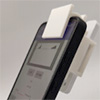| May 07, 2025 |
An inexpensive paper sensor along with a smartphone-based reader can rapidly provide information on a person’s personal smoke exposure during wildfire season.
(Nanowerk News) An inexpensive paper sensor along with a smartphone-based reader developed by a Washington State University-led team can rapidly provide information on a person’s personal smoke exposure during wildfire season.
|
|
The sensor can provide valuable information for firefighters and others to clarify just how much harmful pollution they might inhale during smoky conditions. The researchers, including from University of Washington and University of Georgia, report on their work in the journal, ACS Applied Materials and Interfaces (“Mesoporous Pd@Pt Nanoparticle Label/Lateral Flow Immunoassay Integrated with a 3D-Printed Smartphone Reader for Detection of Wood Smoke Biomarkers”).
|
|
The paper biosensor uses tiny, flower-like particles of palladium and platinum to detect and amplify the signal from wildfire smoke biomarkers in urine. To make the system field-ready, the team also developed a custom 3D-printed smartphone reader and app, allowing users to rapidly scan and quantify their exposure on-site.
|
|
“Our goal is to quickly identify the exposure onsite in real time and report it with a smartphone reader, so agencies can quickly identify the exposure level and location and make decisions for a hazard prevention strategy,” said Annie Du, a research professor in WSU’s School of Mechanical and Materials Engineering who is leading the project.
|
|
With the increasing number and size of wildfires in recent years, researchers would like better information on people’s personal smoke exposure to understand and mitigate its health impacts more effectively. Human exposure to wood smoke is linked to numerous health issues, including respiratory disease, cardiovascular disease, and lung cancer.
|
|
Currently, estimates of a person’s smoke exposure level are not exact. Agencies determine how much smoke a person may be exposed to based on computer models that use regional meteorology, satellite data, air quality sensors in the region, or even personal perceptions of smoke levels. Those methods sometimes miss the big variations in smoke that can happen in a small area. They also don’t get a person’s specific exposure levels to chemicals or how a person might variably metabolize and process pollutants in his or her body.
|
|
Furthermore, exposure to pollutants from wildfires could have impacts on people – even if they don’t have a lot of symptoms.
|
|
“You’re exposed to smoke when you breathe in the polluted air, but your body changes that to a metabolite and introduces changes to your DNA,” said Du, who is also in the College of Pharmacy and Pharmaceutical Sciences. “That’s why we are focused on early detection — We want to catch biological changes before clinical symptoms appear.”
|
|
There are blood tests to measure smoke exposure, but they’re cumbersome and expensive, requiring that samples be sent to a laboratory for analysis. When fires are in remote areas, getting information on a person’s exposure is even more difficult.
|
|
With the test strips, the researchers were able to measure tiny amounts of metabolites from the pollutant benzene. Their biosensor device is low-cost and very sensitive to the signal of the benzene metabolites.
|
|
Unlike a COVID test strip, which only determines whether or not a person has COVID, their sensor can quantify the amount of harmful chemicals someone has been exposed to. The 3D-printed sensor can be connected to a smartphone, so that using a phone’s location data, researchers can determine exactly where smoke levels are most hazardous and identify the chemicals present in different neighborhoods.
|
|
The researchers have tested the strips in a lab setting. They will now begin testing the strips with firefighters during the wildfire season and comparing them to standard lab tests. While they will initially test with wildland firefighters, they are working with WSU’s Office of Commercialization and plan to adapt and expand the technology to other vulnerable populations in the future. The work was funded by the Centers for Disease Control and Prevention.
|

